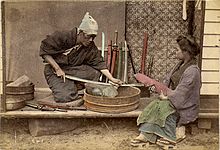Tu carrito está vacío


Japan is widely recognized as being one of the leading producers of high-quality swords and other bladed weapons. The island nation pioneered the use of differential heat treatment as well as tamahagane steel. Using these two processes, Japan has crafted some of the finest quality swords the world has ever seen.
While most people are familiar with the Japanese katana, there are were other swords produced in this region. In this post, we're going to look back at some of the earliest Japanese swords, revealing when they were produced and how they shaped the country's swordmaking craft into what it is today.
Jokoto
Historians generally categorize traditional Japanese swords by the time period in which they were produced. The earliest swords, for instance, were made prior to 900 A.D. Dubbed jokoto, not much is known about these early Japanese swords. However, some historians believe that Japanese swordsmiths used techniques borrowed from their Chinese counterparts to produce jokoto swords.
Koto
Swords produced in Japan from 987 to 1597 are called koto,which literally translates into "old swords." According to Wikipedia, koto swords are the pinnacle of Japanese swordcrafting, featuring curved edges and high-carbon steel. So, while jokoto swords were generally straight, koto swords were curved.
The use of a curved blade offered several key benefits, one of which is its balanced strength and flexibility. Japanese swordsmiths created swords with a curved blade by heating and cooling different parts of the blade at different rates. This allowed for a stronger edge and a softer, more flexible spine. And as the blade cooled, it also produced a curved edge -- a feature that's characteristic of genuine Japanese swords like the katana.
Shinto
Following koto swords was shinto, which translates to "new swords." It's a common assumption that Japanese swords became better over time, but this isn't necessarily true. The beginning of the shinto period of Japan's sword production saw a decline in sword quality. The famous Japanese swordsmith Suishinshi Masahide (c. 1750–1825) even discussed this belief in his written publications, stating that shinto swords were inferior to their koto counterparts.
Shinshinto
While sinto means "new swords," shinshinto means "new new swords." Shinshinto swords were produced in 1781 to 1876. Due to the controversy surrounding the sub-part quality of shinto swords, Japanese swordmakers emphasized strength and quality when producing shinshinto swords. They often looked like Western-style cavalry swords, featuring a greater curvature of the blade and shorter overall length.
These are just a few of the earliest examples of Japanese swords.